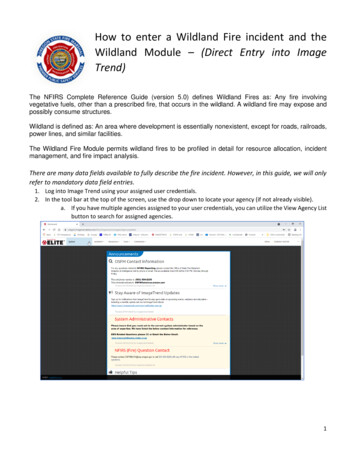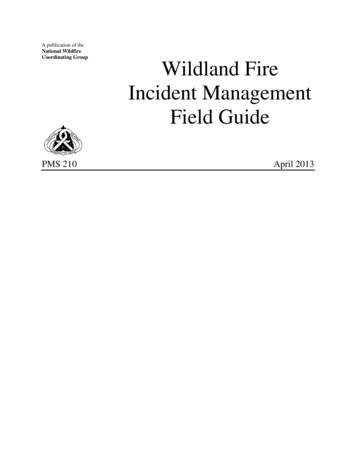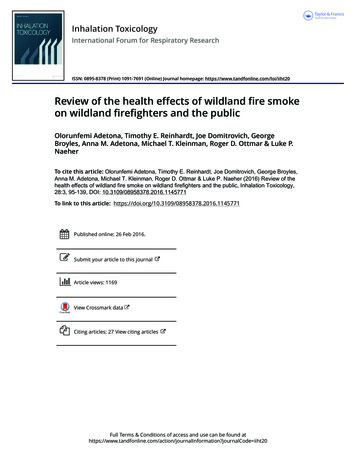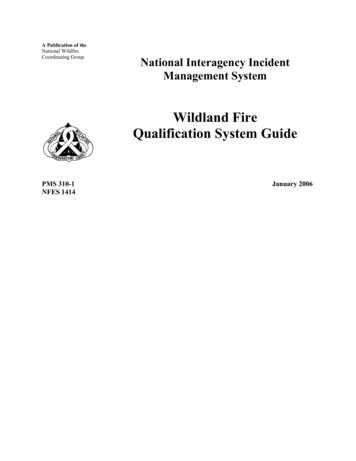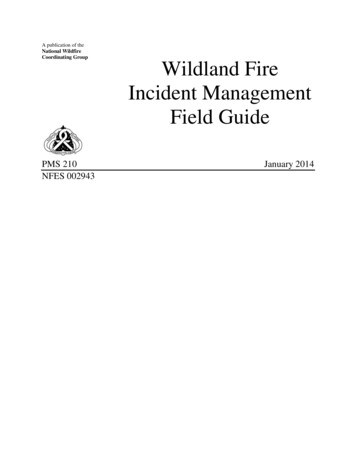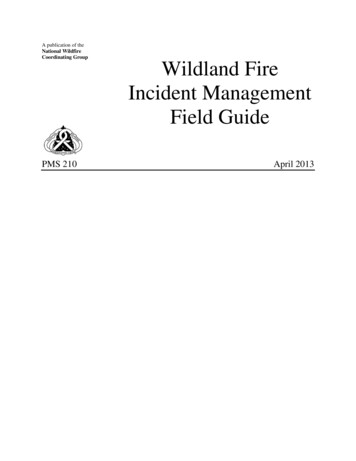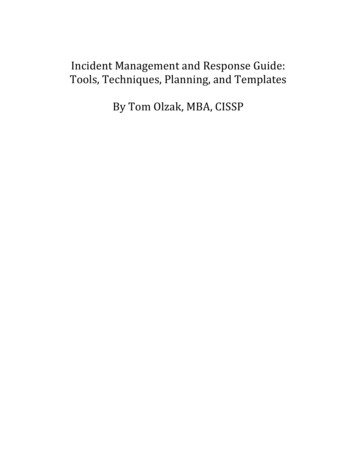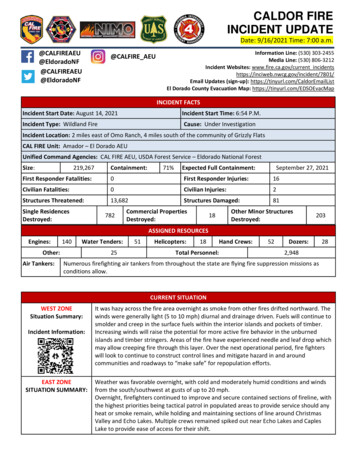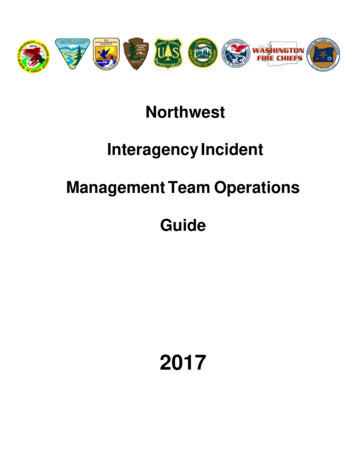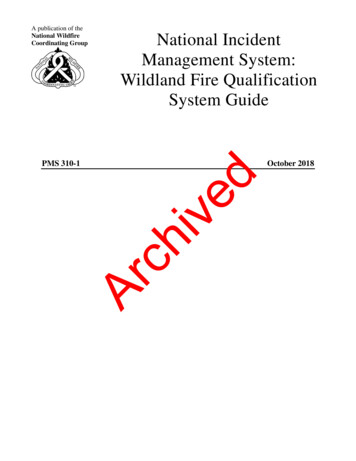
Transcription
A publication of theNational WildfireCoordinating GroupNational IncidentManagement System:Wildland Fire QualificationSystem GuideOctober 2018ArchivedPMS 310-1
National Incident Management System:Wildland Fire Qualification System GuideOctober 2018PMS 310-1The National Incident Management System: Wildland Fire Qualification System Guide standardizes theminimum National Wildfire Coordinating Group (NWCG) requirements for federal state, and localagencies in providing resources to fill a national interagency request for all types of wildland fireincidents.The Guide:Outlines the minimum requirements for training, experience, physical fitness level, and currencystandards for wildland fire positions, which all participating agencies have agreed to meet fornational mobilization. Standards may be augmented to meet specific needs within an agency, butthe augmentation cannot be imposed by an agency on its cooperators who meet the minimumsoutlined in this guide. Allows cooperating agencies to jointly agree upon training, experience, physical fitness level,and currency standards to meet fire management needs for wildland fire (includes wildfire andprescribed fire). Establishes minimum qualifications for personnel involved in prescribed fires on whichresources of more than one agency are utilized—unless local agreements specify otherwise.chived ArAny organization or agency providing resources to fill a national interagency request for all types ofwildland fire incidents will meet the minimum NWCG requirements described in this guide.NWCG recognizes the ability of cooperating agencies at the local level to jointly define and accept eachother’s qualifications for initial attack, extended attack, large fire operations, and prescribed fire.The National Wildfire Coordinating Group (NWCG) provides national leadership to enableinteroperable wildland fire operations among federal, state, tribal, territorial, and local partners. NWCGoperations standards are interagency by design; they are developed with the intent of universal adoptionby the member agencies. However, the decision to adopt and utilize them is made independently by theindividual member agencies and communicated through their respective directives systems.
Summary of ChangesPage 7 – Revision Process: modified language to read:Required information includes reason for the change, national mobilization statisticsdemonstrating position need and use, a draft position task books (PTB) (if appropriate), and anyspecific transition or implementation plan information for individuals currently residing in theIncident Qualification and Certification System (IQCS) and the Incident Qualification System(IQS).2.Page 7 – Position Task Book:Add new language to clarify use of PTB when a new revised PTB is approved:When a new or revised PTB is published, current Trainees with an initiated PTB (including thoseindividuals re-initiating or re-certifying) and at least one documented experience should continueto use their current PTB. Individuals with no tasks completed will use the new or revised PTB.Currently qualified individuals will not be affected by the transition to new or revised PTBs.3.Page 14 – Positions with the Same Position Task Book for Type 2 and Type 1Remove Helibase Manager Type 2 & Type 1 (HEB2 and HEB1)4.Page 18 – Incident Command System PositionsRemove Helibase Type 1 (HEB1) and Helibase Type 2 (HEB2)Added Helibase Manager (HEBM)5.Page 25 – Incident Commander Type 1 (ICT1)Add Liaison Officer (LOFR) to ICT1 Maintains Currency For These Positions6.Page 27 – Incident Commander Type 2 (ICT2)Add Liaison Officer (LOFR) to ICT2 Maintains Currency For These Positions7.Page 29 - Incident Commander Type 3 (ICT3)Added Type 3 All-Hazard Incident Management Team (O-305) to Other Training WhichSupports Development of Knowledge and Skills8.Page 35 – Public Information Officer Type 1 (PIO1)Added “Individuals utilizing this pathway must complete the Public Information Officer Course(E/L 952) prior to position qualification.”9.Page 36 – Public Information Officer Type 2 (PIO2)Added “Individuals utilizing this pathway must complete the Public Information Officer Course(E/L 952) prior to position qualification.”10.Page 38 – Liaison Officer (LOFR)Added Incident Commander Type 1 (ICT1) and Incident Commander Type 2 (ICT2) to ThesePositions Maintain Currency for LOFR11.Page 49 – Operations Section Chief, Type 3 Wildland Fire (OPS3)Added Type 3 All-Hazard Incident Management Team (O-305) to Other Training WhichSupports Development of Knowledge and SkillsArchived1.National Incident Management System: Wildland Fire Qualifications System Guidei
Page 75 – Air Operation Branch Director (AOBD)Changed Helibase Manager Type 1 (HEB1) to Helibase Manager (HEBM) under AOBDMaintains Currency for These Positions13.Page 76 – Air Support Group Supervisor (ASGS)Changed Helibase Manager Type 1 (HEB1) to Helibase Manager (HEBM) to RequiredExperience and ASGS Maintains Currency for These Positions14.Page 77 – Helibase Type 1 (HEB1) and Helibase Type 2 (HEB2)Combined to Helibase Manager (HEBM)15.Page 78 – Helicopter Manager, Single Resource Boss (HMGB)Changed Helibase Manager Type 1 and Helibase Manager Type 2 to Helibase Manager (HEBM)16.Page 79 – Helicopter Crewmember (HECM)Changed Helibase Manager Type 1 and Helibase Manager Type 2 to Helibase Manager (HEBM)17.Page 80 – Air Tactical Group Supervisor (ATGS)Modified Agency Approved Crew Resource Management (CRM) Training to Required Training18.Page 82 – Single Engine Airtanker Manager (SEMG)Added the following to Required Training:a. FAA NOTAM System (A-103)b. Automated Flight Following (A-115)c. Basic Airspace (A-203)chived12.Added Satisfactory performance as Ramp Manager (RAMP) to Required ExperienceAdded Airtanker Base Manager (ATBM) and Fixed Wing Base Manager (FWBM) to ThesePositions Maintain Currency for SEMGArAdded Ramp Manager (RAMP), Fixed Wing Parking Tender (FWPT), and Aircraft Timekeeper(ATIM) to SEMG Maintains Currency for These Positions19.Page 83 – Deck Coordinator (DECK)Changed Helibase Manager Type 2 (HEB2) to Helibase Manager (HEBM) under ThesePositions Maintains Currency for DECK20.Page 84 – Aircraft Base Radio Operator (ABRO)Changed Helibase Manager Type 2 (HEB2) to Helibase Manager (HEBM) under ThesePositions Maintains Currency for ABRO21.Added the following new Airtanker Base positions:a. Aircraft Timekeeper (ATIM)b. Airtanker Base Manager (ATBM)c. Fixed Wing Base Manager (FWBM)d. Fixed Wing Parking Tender (FWPT)e. Ramp Manager (RAMP)f. Mixmaster (MXMS)g. Retardant Crewmember (RTCM)National Incident Management System: Wildland Fire Qualifications System Guideii
Added the following Unmanned Aircraft System positions:a. Unmanned Aircraft System Pilot (UASP)b. Unmanned Aircraft System, Module Leader (UASL)c. Unmanned Aircrafty System, Manager (UASM)d. Unmanned Aircraft System, Data Specialist (UASD)23.Page 98 – Planning Section Chief Type 1 (PSC1)Added “Individuals utilizing this pathway must complete the Planning Section Chief Course(S- 440) prior to position qualification.”24.Page 99 – Planning Section Chief Type 2 (PSC2)Added “Individuals utilizing this pathway must complete the Planning Section Chief Course(S- 440) prior to position qualification.”25.Page 101 – Planning Section Chief Type 3 (PSC3)Added Type 3 All-Hazard Incident Management Team (O-305) to Other Training WhichSupports Development of Knowledge and Skills.26.Page 120 – Logistics Section Chief Type 1 (LSC1)Added “Individuals utilizing this pathway must complete the Logistics Section Chief Course(E/L967) prior to position qualification.”27.Page 122 – Logistics Section Chief Type 2 (LSC2)Added “Individuals utilizing this pathway must complete the Logistics Section Chief Course(E/L967) prior to position qualification.”28.Page 124 – Logistics Section Chief Type 3 (LSC3)Added Type 3 All-Hazard Incident Management Team (O-305) to Other Training WhichSupports Development of Knowledge and Skills.29.Page 147 – Finance Section Chief Type 3 (FSC3)Added Type 3 All-Hazard Incident Management Team (O-305) to Other Training WhichSupports Development of Knowledge and Skills.30.Miscellaneous:Archived22.a. Remove reference ‘on a wildland fire or prescribed fire incident’ from all requiredexperience.b. Course name change for M-581 – Fire Program Management, an Overview.c. Course name update for e-ISuite, All Modules.National Incident Management System: Wildland Fire Qualifications System Guideiii
Table of ContentsPosition Competency and Behavior Guidance.1Description of the Performance-Based System .2Certification and Recertification .2Position Qualifications .3Required Training . 3Recurrent Training. 3Required Experience. 3Physical Fitness Levels . 4Currency Requirements . 4Other Training Which Supports Development of Knowledge and Skills . 5NWCG Directives .5Skills Crosswalk for Structural Firefighters . 5chivedWildfire Incident Complexity .5Prescribed Fire Complexity .6Nationally Mobilized Area Command, Type 1 and Type 2 Incident Management Teams .6Review and Update Process for the PMS 310-1 and Position Task Books .6PMS 310-1 . 6Position Task Books . 7Position Task Book Design and Use .8ArPosition Task Book Initiation . 8Position Task Book Completion Timeframes . 8Position Task Book Sections . 8Position Task Book Responsibilities . 10Position Task Book Considerations and Exceptions .14Positions Without NWCG Position Task Books . 14Positions With the Same Position Task Book for Type 2 and Type 1 Complexity Levels . 14Positions With Combined Position Task Books . 14Position Categories.16Criteria for Position Consideration in the PMS 310-1 . 16Incident Command System Positions . 18Wildland Fire Positions . 20Incident Support Positions . 21Associated Activities Positions . 22National Incident Management System: Wildland Fire Qualifications System Guideiv
Qualifications for Command Positions .23chivedArea Commander (ACDR) . 24Incident Commander Type 1 ( ICT1) . 25Incident Commander Type 2 (ICT2) . 26Incident Commander Type 3 (ICT3) . 28Incident Commander Type 4 (ICT4) . 30Incident Commander Type 5 (ICT5) . 31Safety Officer Type 1 (SOF1) . 32Safety Officer Type 2 (SOF2) . 33Safety Officer, Line (SOFR) . 34Public Information Officer Type 1 (PIO1) . 35Public Information Officer Type 2 (PIO2) . 36Public Information Officer (PIOF) . 37Liaison Officer (LOFR) . 38Agency Representative (AREP) . 39Prescribed Fire Manager Type 1 (RXM1). 40Prescribed Fire Manager Type 2 (RXM2). 41Prescribed Fire Burn Boss Type 1 (RXB1) . 42Prescribed Fire Burn Boss Type 2 (RXB2) . 43Qualifications for Operations Positions .45ArOperations Section Chief Type 1 (OSC1) . 46Operations Section Chief Type 2 (OSC2) . 47Operations Branch Director (OPBD) . 48Operations Section Chief Type 3, Wildland Fire (OPS3) . 49Structure Protection Specialist (STPS) . 50Division/Group Supervisor (DIVS) . 51Task Force Leader (TFLD) . 53Strike Team Leader Crew (STCR) . 55Strike Team Leader Heavy Equipment (STEQ) . 57Strike Team Leader Engine (STEN) . 59Crew Representative (CREP) . 61Crew Boss, Single Resource (CRWB) . 62Heavy Equipment Boss, Single Resource (HEQB) . 63Engine Boss, Single Resource (ENGB) . 64Felling Boss, Single Resource (FELB) . 65Firing Boss, Single Resource (FIRB) . 66Staging Area Manager (STAM) . 67Firefighter Type 1 (FFT1) . 68Firefighter Type 2 (FFT2) . 69National Incident Management System: Wildland Fire Qualifications System Guidev
Advanced Faller (FAL1) . 70Intermediate Faller (FAL2) . 71Basic Faller (FAL3) . 72Qualifications for Air Operations Positions .73ArchivedArea Command Aviation Coordinator (ACAC). 74Air Operations Branch Director (AOBD) . 75Air Support Group Supervisor (ASGS) . 76Helibase Manager (HEBM) . 77Helicopter Manager, Single Resource (HMGB)* . 78Helicopter Crewmember (HECM) . 79Air Tactical Group Supervisor (ATGS) . 80Helicopter Coordinator (HLCO) . 81Single Engine Airtanker Manager (SEMG) . 82Deck Coordinator (DECK) . 83Aircraft Base Radio Operator (ABRO) . 84Aircraft Timekeeper (ATIM) . 85Airtanker Base Manager (ATBM). 86Fixed Wing Base Manager (FWBM) . 87Fixed Wing Parking Tender (FWPT) . 88Ramp Manager (RAMP) . 89Mixmaster (MXMS) . 90Retardant Crewmember (RTCM) . 91Unmanned Aircraft System, Data Specialist . 92Unmanned Aircraft System, Manager . 93Unmanned Aircraft System, Module Leader . 94Unmanned Aircraft System Pilot. 95Qualifications for Planning Positions .97Assistant Area Commander, Planning (ACPC). 98Planning Section Chief Type 1 (PSC1) . 99Planning Section Chief Type 2 (PSC2) . 100Planning Section Chief Type 3 (PSC3) . 102Situation Unit Leader (SITL) . 103Field Observer (FOBS). 104Geographic Information System Specialist (GISS) . 105Display Processor (DPRO) . 106Demobilization Unit Leader (DMOB) . 107Resources Unit Leader (RESL) . 108Status/Check-In Recorder (SCKN) . 109Documentation Unit Leader (DOCL) . 110National Incident Management System: Wildland Fire Qualifications System Guidevi
Strategic Operational Planner (SOPL) . 111Long Term Fire Analyst (LTAN) . 112Fire Behavior Analyst (FBAN) . 113Fire Effects Monitor (FEMO). 114Incident Training Specialist (TNSP) . 115Human Resource Specialist (HRSP) . 116Interagency Resource Representative (IARR) . 117Infrared Interpreter (IRIN) . 118Qualifications for Logistics Positions .119ArchivedAssistant Area Commander, Logistics (ACLC) . 120Logistics Section Chief Type 1 (LSC1) . 121Logistics Section Chief Type 2 (LSC2) . 123Logistics Section Chief Type 3 (LSC3) . 125Service Branch Director (SVBD) . 126Support Branch Director (SUBD) . 127Medical Unit Leader (MEDL) . 128Communications Unit Leader (COML) . 129Incident Communications Technician (COMT) . 130Incident Communications Center Manager (INCM) . 131Radio Operator (RADO) . 132Food Unit Leader (FDUL) . 133Supply Unit Leader (SPUL) . 134Ordering Manager (ORDM) . 135Receiving and Distribution Manager (RCDM) . 136Facilities Unit Leader (FACL) . 137Base/Camp Manager (BCMG) . 138Ground Support Unit Leader (GSUL) . 139Equipment Manager (EQPM). 140Security Manager (SECM) . 141Qualifications for Finance/Administration Positions.143Finance/Administration Section Chief Type 1 (FSC1) . 144Finance/Administration Section Chief Type 2 (FSC2) . 145Finance/Administration Section Chief Type 3 (FSC3) . 147Time Unit Leader (TIME) . 148Personnel Time Recorder (PTRC). 149Cost Unit Leader (COST) . 150Compensation/Claims Unit Leader (COMP) . 151Compensation-for-Injury Specialist (INJR) . 152Claims Specialist (CLMS) . 153National Incident Management System: Wildland Fire Qualifications System Guidevii
Procurement Unit Leader (PROC) . 154Equipment Time Recorder (EQTR) . 155Commissary Manager (CMSY) . 156Incident Business Advisor (INBA). 157Incident Contract Project Inspector (ICPI) . 158Qualifications for Dispatch Positions .159Expanded Dispatch Coordinator (CORD) . 160Expanded Dispatch Supervisory Dispatcher (EDSP) . 161Expanded Dispatch Support Dispatcher (EDSD) . 162Expanded Dispatch Recorder (EDRC) . 163Initial Attack Dispatcher (IADP). 164Aircraft Dispatcher (ACDP) . 165Qualifications for Prevention and Investigation Positions.167chivedFire Prevention Education Team Leader (PETL) . 168Fire Prevention Education Team Member (PETM) . 169Wildland Fire Investigation Team Member (INTM) . 170Wildland Fire Investigator (INVF) . 171Position Qualification Flowcharts .173ArArea Command . 174Command .
National Incident Management System: Wildland Fire Qualifications System Guide iii 22. Added the following Unmanned Aircraft System positions: a. Unmanned Aircraft System Pilot (UASP) b. Unmanned Aircraft System, Module Leader (UASL) c. Unmanned Aircrafty System, Manager (UASM) d. Unmanned Aircraft System, Data Specialist (UASD) 23.
